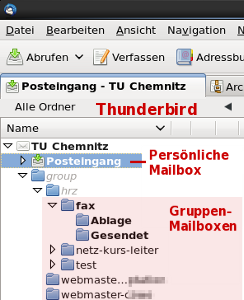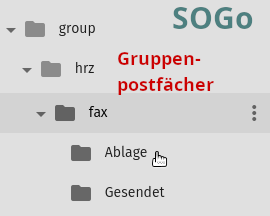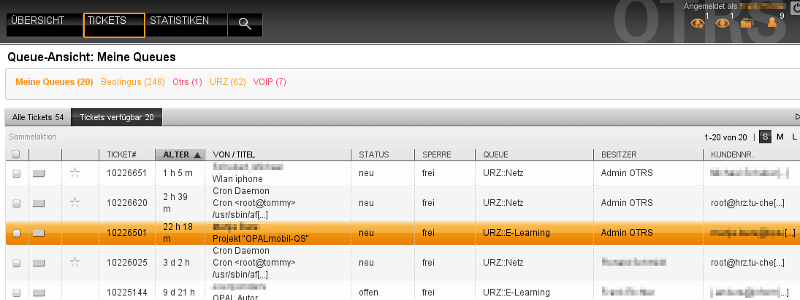Solutions for person-independent e-mail addresses
- 1. Forwarding the e-mail to a person via alias
- 2. Distributing the e-mail to a mailing list (distribution list)
- 3. Delivery of the e-mail to a shared mailbox (group mailbox)
- 4. Processing the e-mail with a Trouble Ticket System
E-mail addresses at Chemnitz University of Technology are generally person-related, i.e. at vorname.name@unit.tu-chemnitz.de
you can reach exactly one person who needs his or her personal user ID and password to read the e-mail.
However, there is often the wish to assign e-mail addresses for institutions (faculties, professorships, projects) or functions (dean, responsible person, info).
- This address should be independent of the person.
- The e-mail should be able to be processed by certain persons.
- This group of persons can change (e.g. in the case of a substitute), but the e-mail address remains the same.
For example, the (imaginary) professorship "Bitmagie" of the Faculty of Computer Science should be reachable via:
bitmagie@informatik.tu-chemnitz.de.
This e-mail should normally be handled by the secretary, in case of a substitute by a colleague.
Of course, the professor would also like to have access to the mailbox.
To deliver an e-mail to a general, person-independent address, we offer the following possibilities:
Forwarding the e-mail to a person via Alias
An incoming e-mail is delivered to a personal mailbox. In case of a substitution, the mail administrator must be informed, who changes the forwarding.
Problem: The e-mail can be read by one person only, the e-mail ends up in his or her personal mailbox.
The personal password must not be passed on to anyone - this would violate the URZ user regulations! You can allow other people to access your personal mailbox by setting access rights - but they will then see all the e-mails there.
To set up an alias, please contact the URZ Helpdesk: e-mail to support@hrz.tu-chemnitz.de.
2. Distributing the e-mail to a Mailing list (distribution list)
Incoming e-mail is distributed to several recipients to their personal mailboxes. In case of substitution, the administrator of the mailing list must change the members.
Problem: The processing status of the e-mail is not visible, possibly several people answer the e-mail (or rely on each other). This could be solved by organisational measures: Define responsibilities; when an e-mail is answered, a copy should be sent to the distribution list.
Further information on mailing lists, e.g. setting up a mailing list
3. Delivery of the e-mail to a Shared mailbox (Group mailbox)
Incoming e-mail is delivered to a shared mailbox, which can be accessed by several persons (with their usual personal logins and passwords).
- The access rights can be differentiated (and changed) (e.g. "read only" or "read+write").
- The personal e-mails are not mixed with the e-mails of the shared mailbox.
- The processing status (read, answered) can be viewed.
- In the event of a substitution, the administrator of the shared mailbox must give the substitute the corresponding rights.
Depending on whether you and the participants have their mailboxes on the normal mail server or in Exchange, you should also have the shared mailbox created there. Below is the description for a shared mailbox in the normal Cyrus mail server:
Prerequisite: An IMAP-capable mail program must be used, e.g. Thunderbird, Outlook, or Webmail. Mail programs that are set to the older POP protocol cannot use this variant.


After setting up the shared mailbox, it appears in the folder overview. If this is not the case, subscribe to the shared mailbox: Thunderbird: Click right on the account /left panel) → Subscribe: Click on the shared folder in the hierarchy.
You must then monitor another mailbox in addition to your personal mailbox. For better organisation, you can create further subfolders in the shared mailbox (e.g. "Done"), in which certain mails are then filed. However, this requires a certain discipline on the part of all users. In the Thunderbird e-mail programme and in Webmail, this is shown in the picture on the right.
To ensure that sent e-mails also carry the sender address of this shared mailbox, an additional identity must be created in the e-mail program. In Webmail, this can be done via "Gear icon" → Preferences → Mail → Personal Information, in Thunderbird via the menu Settings → Account settings: Create the functional e-mail address under "Additional identities".
You can request a shared mailbox as a staff member in the IdM portal. There you will find a tab Shared mailboxes under E-mail. Click on Create new shared mailbox and enter the desired e-mail address of the shared mailbox (lower case letters and minus signs are allowed) as well as the duration (before the expiration you will be contacted for renewal). After the URZ has created the shared mailbox, you can add additional persons responsible for substitutions.
Adjusting access rights
New since May 2025: For shared mailboxes that have already been converted, the resource owners also set the access rights in the IdM portal: E-Mail → Shared mailboxes, click there on the relevant shared mailbox → Manage access. Here resource owners may add and remove users. Write access will be granted or deleted on all existing subfolders. The resource owners who are responsible for extending or deleting the shared mailbox and assigning authorizations can also be set here.
If the procedure just mentioned does not work, your shared mailbox has not yet been converted. Please contact us or set the access rights via Webmail. Please read hints in Where do I change access rights for shared mailboxes?
See also: Exchange-Gruppenpostfächer
4. Processing the e-mail with a Trouble Ticket System
If there are several agents to answer requests to one e-mail address, even a shared mailbox quickly becomes confusing. In this case, it is advisable to use a web-based system – a so-called trouble ticket system, which offers many more functions for order processing than a mail programme, but also requires a certain amount of training. Criteria for the use of such a trouble ticket system are:
- The e-mails trigger orders or are requests for services that are to be answered by several agents in a short, defined time.
- The processes triggered by the e-mails must be processed by several employees one after the other (workflow).
- The processing of orders or enquiries should be traceable and documented. At any one time, exactly one person is responsible for an order.
- In the event of delays, the system should react appropriately, e.g. in the case of illness of the agent.
- Telephone enquiries should also be recorded and comprehensibly documented as a process.
The URZ, as a service institution for the TU, has been using the Open Trouble Ticket System OTRS for its users' enquiries and requests since 2007.
All e-mails sent to our helpdesk address support@hrz.tu-chemnitz.de end up here.
The user immediately receives a reply with a case number, and the URZ staff answer the enquiries or distribute them to the relevant staff.
Queries are automatically assigned to the case. For example, all orders, enquiries and failure reports for VoIP services are processed via OTRS.
The orders can also be sent by the users via a web form.
In this way, an agent can see his or her tasks in a web browser:

In 2008, over 9000 requests and orders were answered with the help of OTRS.
The trouble ticket system is also used by other institutions besides the URZ.
If you would like to use or get to know the system for incident processing, please contact us.
Send an e-mail to support@hrz.tu-chemnitz.de – and we will process your request via OTRS.
